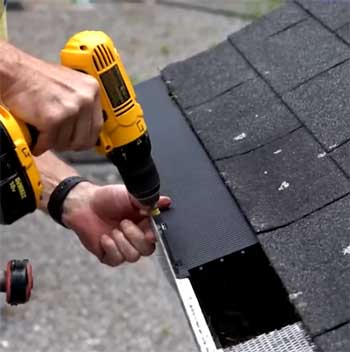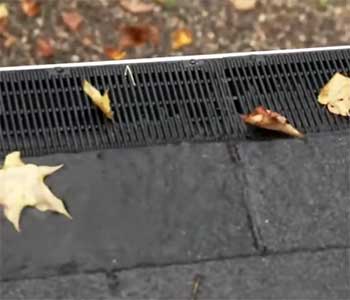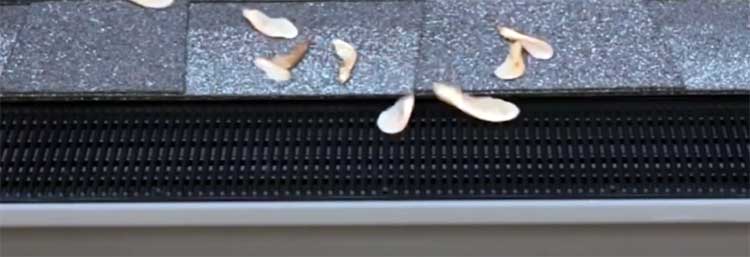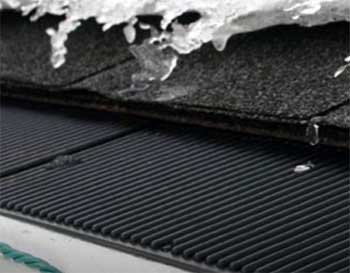I’m no stranger to the hassle of clogged gutters, and if you’re reading this, you probably aren’t either. After years of battling leaves, twigs, and who-knows-what-else piling up in my gutters, I found RainDrop Gutter Guards.
These aren’t just another gimmick—they’re a game-changer for keeping your home’s gutter system flowing smoothly. With their unique design and solid performance, they’ve saved me countless hours of maintenance and stress. Trust me, if you’re tired of climbing ladders to clean gutters, RainDrop is worth every penny. Let’s get into my experience and why these guards stand out.
My Experience With RainDrop Gutter Guards

Picture this: it’s a rainy Saturday, and I’m staring out my window, watching water cascade off my roof like a waterfall because my gutters are, once again, clogged.
I live in a suburban neighborhood surrounded by towering oaks and pines, so debris is my nemesis.
Fed up, I decided to try RainDrop Gutter Guards after a friend raved about them.
I was skeptical—gutter guards always seem to promise the moon but deliver a mess.
Still, I took the plunge and had them installed on my two-story home.
The installation was a breeze, thanks to a local contractor who knew their stuff. RainDrop’s design, with its polypropylene grid and UV stabilizers, looked sturdy right out of the box. Unlike the flimsy mesh guards I’d tried before, these felt like they could take a beating.
Once installed, they blended seamlessly with my roofline, tucked neatly under the shingles. I barely noticed them from the ground, which was a huge plus for my home’s curb appeal.
The real test came during a massive spring downpour. I stood outside (yes, I’m that person) to see how they’d hold up. To my amazement, water flowed effortlessly into the gutters while leaves and pine needles slid right off the smooth surface.
No overflow, no clogs—just a steady stream through the downspouts. Over the past year, I’ve checked the gutters a handful of times, and they’ve stayed remarkably clean. Sure, a few tiny seeds got through, but nothing a quick rinse couldn’t handle.
Compared to my old routine of cleaning gutters every few months, RainDrop has been a lifesaver. It’s not perfect—nothing is—but it’s the closest I’ve come to a low-maintenance gutter solution.
Pros of RainDrop Gutter Guards
- Exceptional Durability

Let’s talk about toughness.
RainDrop Gutter Guards are made from a custom blend of polypropylene mixed with UV stabilizers, which means they laugh in the face of harsh weather.
I’ve seen them withstand blistering summer heat, freezing winter nights, and even a rogue branch or two during a storm.
Unlike some metal mesh guards that dent or rust, these plastic grids hold their shape. I’ve had mine for over a year, and they look as good as the day they were installed. The 20-year transferable warranty is a nice bonus, giving me peace of mind that they’re built to last.
- Handles Heavy Rainfall Like a Champ
If you live in an area with torrential rains (like I do in the Southeast), you’ll appreciate RainDrop’s open-slot design. The guards have hundreds of small slots that let water pour through without getting overwhelmed. During one particularly brutal storm, I watched water rush down my roof, and not a single drop spilled over the gutters.
Other guards I’ve tried—looking at you, cheap mesh—would clog or let water shoot past. RainDrop’s ability to manage high-volume water flow is a standout feature, especially if your home has valleys or steep roof pitches.
- Versatile Fit for Any Roof
One thing I love about RainDrop is how adaptable it is. Whether you’ve got a standard 5-inch or 6-inch gutter, or even something quirkier like a 4-inch or 10-inch setup, these guards can be modified to fit. My home has a mix of gutter sizes, and the installer had no trouble customizing them.
The “Flex-Flange” design makes them compatible with any roof style, from steep pitches to flat roofs. This versatility means you’re not stuck buying a one-size-fits-all product that might not work for your home.
- Low Maintenance (Mostly)
I’m not going to lie—RainDrop isn’t 100% maintenance-free, but it’s pretty darn close. The smooth, slippery surface lets most debris slide off with rain or a gust of wind. Leaves, twigs, and even those pesky maple helicopters don’t stick around long.
I’ve only had to give my gutters a quick rinse once or twice a year to clear out minor debris like pine needles. Compared to the bi-monthly ladder climbs I used to endure, this is a massive win. It’s not perfect, but it’s a huge step up from no guards at all.
- Easy Installation Options
Whether you’re a DIY enthusiast or prefer professional help, RainDrop makes installation straightforward. The guards slip under the shingles and attach to the gutter’s front lip, creating a secure fit. I opted for a pro installer because heights aren’t my thing, but I watched the process, and it looked simple enough for a handy homeowner.
RainDrop’s website even has videos to guide you through the process. Just make sure you measure your gutters accurately to avoid any fit issues. This flexibility makes it accessible for all kinds of homeowners.
Not-So-Good Parts of RainDrop Gutter Guards

- Small Debris Can Sneak Through
RainDrop’s open-slot design is great for water flow, but it’s not foolproof against tiny debris. If you live near pine, maple, or locust trees (like I do), expect some small seeds or needles to slip through the slots. In my experience, these don’t cause major clogs, but they can accumulate over time.
During heavy pollen seasons, I noticed a thin layer of grit in the gutters, which required a quick rinse to clear. It’s not a dealbreaker, but if you’re expecting zero debris, you might be disappointed.
- Professional Installation Can Add Costs
While RainDrop is DIY-friendly, I’d recommend hiring a professional unless you’re confident with ladders and tools. My installation cost a bit more than I’d hoped because my home’s roofline is tricky, with multiple corners and slopes.
The guards themselves are reasonably priced, but labor charges can add up, especially if you need custom adjustments. If you’re on a tight budget, this extra cost might sting, though I’d argue it’s worth it for a proper fit and long-term performance.
- Not Ideal for Every Climate
RainDrop shines in most weather conditions, but it’s not perfect for every environment. In areas with heavy snow or ice, the guards can struggle. I don’t deal with much snow, but a friend in Michigan mentioned that ice can build up on the slots, reducing water flow.
RainDrop does offer gutter heaters as an add-on, but that’s another expense. If you live in a snowy region, you might need to weigh whether the guards’ benefits outweigh the extra maintenance or accessories required.
- Warranty Could Be Longer
The 20-year transferable warranty is solid, but some competitors offer longer coverage—some even lifetime warranties. While I haven’t had any issues with my RainDrop guards, knowing that other brands provide more extended protection makes me wonder if RainDrop could step up their game.
It’s not a huge concern, especially since the guards are so durable, but it’s something to keep in mind if you’re planning to stay in your home for decades.
Maintenance Tips For RainDrop Gutter Guards
- Inspect Annually for Debris

Even though RainDrop reduces maintenance, you’ll still want to check your gutters once a year.
I usually do this in late fall after the leaves have dropped.
Climb up (safely!) or use a pole to inspect the guards for any stuck debris, like pine needles or seed pods.
A quick sweep with a leaf blower or a rinse with a garden hose usually does the trick.
Don’t skip this step—ignoring small buildup can lead to bigger issues down the road.
- Rinse During Pollen Season
If you’re in a pollen-heavy area, give your guards a rinse in spring or early summer. I learned this the hard way when pollen coated my guards and started to clog the slots.
A gentle spray with a hose clears it out in minutes. Just be careful not to use high-pressure water, as it could dislodge the guards if they’re not secured tightly.
- Watch for Ice Buildup
For those in colder climates, keep an eye on ice formation during winter. I don’t deal with this much, but if you do, consider investing in RainDrop’s gutter heaters.
If that’s not in the budget, gently tap the guards with a pole to break up any ice. Avoid letting ice sit too long, as it can block water flow and strain your gutters.
- Check Installation After Storms
After a big storm, take a quick look to ensure the guards are still secure. High winds or falling branches can sometimes loosen them, especially if they weren’t installed perfectly.
I had one corner pop up slightly after a windstorm, but a quick push back into place fixed it. If you notice persistent issues, call your installer to check for proper fastening.
- Pair with Wide-Mouth Downspouts
To maximize RainDrop’s performance, consider upgrading to wide-mouth downspout outlets. I added these to my system, and they’ve made a huge difference in flushing out any small debris that gets through the guards.
They’re especially helpful if you deal with pine needles or other tiny particles that can clog standard downspouts.
Comparison of RainDrop Gutter Guard With Other Gutter Guard Brands
Let’s put RainDrop up against some heavy hitters in the gutter guard world: LeafFilter, GutterGlove Pro, and LeafGuard. I’ve tried a couple of these myself and talked to neighbors about their experiences, so here’s the real scoop.
LeafFilter is the big name in micro-mesh guards, and it’s got a stellar reputation for keeping out even the tiniest debris. Its stainless steel mesh is top-notch, and it’s great for pine needle-heavy areas. But here’s the catch: it’s pricey—often double the cost of RainDrop—and requires professional installation.
I found LeafFilter’s performance similar to RainDrop’s in heavy rain, but the high cost and lack of DIY options made RainDrop more appealing for my budget.
GutterGlove Pro is another micro-mesh contender, often praised for its durability and DIY-friendly kits. It’s a solid choice, but I noticed it struggles with heavy water flow compared to RainDrop. A neighbor complained that GutterGlove clogged during a downpour, letting water spill over.
RainDrop’s open-slot design handles high-volume rain better, and it’s easier to clean when small debris builds up. GutterGlove’s price is closer to RainDrop’s, but I prefer RainDrop’s versatility across gutter sizes.
LeafGuard’s surface tension system is unique, using a curved cover to funnel water while deflecting debris. It’s sleek and low-maintenance, but it’s not perfect. My cousin has LeafGuard, and while it looks great, pine needles still sneak in, and the installation cost was astronomical.
RainDrop offers similar performance at a fraction of the price, and I like that it doesn’t require a full gutter replacement like LeafGuard often does.
Overall, RainDrop strikes a balance between affordability, performance, and ease of use. It’s not as fine-tuned as LeafFilter for tiny debris, but it’s more versatile and budget-friendly.
Compared to GutterGlove and LeafGuard, RainDrop’s ability to handle heavy rain and fit any roof makes it a standout for most homeowners.
Frequently Asked Questions (FAQ)
In my experience, yes, RainDrop gutter guards are absolutely worth it if you’re looking to cut down on gutter maintenance without breaking the bank. They’re durable, handle heavy rain well, and fit a wide range of gutter sizes. While they let some small debris through, the reduced cleaning time and solid performance make them a smart investment. If you live in an area with heavy tree cover or frequent storms, they’ll save you hours of ladder time.
It’s tough to pin down one “highest rated” gutter guard since it depends on your needs, but LeafFilter often takes the crown in reviews for its micro-mesh design that blocks nearly all debris. That said, RainDrop is a close contender for its balance of performance and affordability. Consumer reviews and my own experience suggest RainDrop is a top pick for versatility and value, especially if you don’t need the ultra-fine filtration of pricier options.
Consumer Reports hasn’t updated their gutter guard review since 2010, when they named LeafFilter the top professionally installed guard and GutterGlove Pro the best DIY option. Both are micro-mesh systems, great for small debris. However, the market has evolved, and RainDrop’s unique design offers similar benefits at a lower cost. Without newer data, I’d say RainDrop holds its own against these older picks for most homeowners.
LeafGuard’s surface tension system is sleek and effective at deflecting large debris, but it has drawbacks. It’s expensive, often requiring a full gutter replacement, which can cost thousands. Small debris like pine needles can still get in, and cleaning them is trickier than with RainDrop’s open-slot design. Plus, LeafGuard’s proprietary system limits your installation options to their contractors, which can drive up costs compared to RainDrop’s DIY-friendly approach.
Why RainDrop Gutter Guards Are A Must-Have?
After a year with RainDrop Gutter Guards, I’m sold. They’ve slashed my gutter-cleaning time, handled brutal storms, and kept my home’s exterior looking sharp. No product is perfect, but RainDrop’s durability, versatility, and low maintenance make it a standout.
If you’re ready to say goodbye to clogged gutters and hello to peace of mind, give RainDrop a shot. You’ll wonder why you didn’t install them sooner.

I live in Wisconsin where leaves and snow are the problem. I finally installed a gutter guard system with fine mesh. Our first snow was 11” and the snow just sat on the guards and froze. I read in your article that this can happen with raindrop also. I could have installed gutter heaters and sparred the cost of the guards. What makes raindrop any better and are there reviews that address this issue?